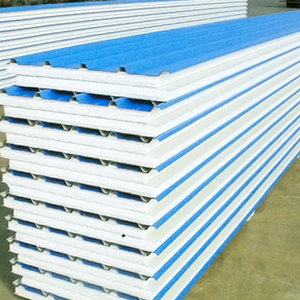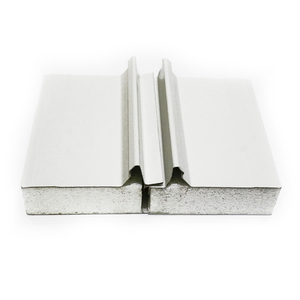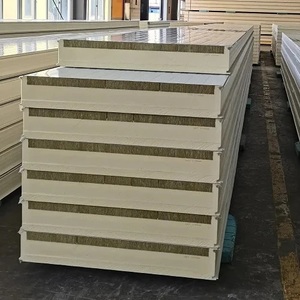
All categories
Featured selections
Trade Assurance
Buyer Central
Help Center
Get the app
Become a supplier

(104318 products available)














































A sandwich panel is a composite panel made of two outer layers and a core layer. The two outer layers are usually made of metal sheets like steel or aluminum, and the core layer can be foam, paper honeycomb, or mineral wool. Sandwich panels are used in construction because they are lightweight, and strong, and provide good insulation. These panels are also used in refrigeration, automotive, and marine applications. Here are the different types of sandwich panels:
PU/PIR Sandwich Panels
These panels are also called polyurethane or PIR panels. They have a core of polyurethane foam or PIR. PU panels have a higher R-value per inch than any other foam core. They provide excellent thermal insulation. PU panels are lightweight and have high structural integrity. They are used in many applications, from cold storage facilities to commercial buildings. PIR panels provide good fire resistance. They are suitable for projects requiring stringent building codes.
EPS Sandwich Panels
These panels have a core of expanded polystyrene foam. EPS panels are more economical than PU panels. They offer a good balance between cost and thermal performance. EPS has a lower density than PU foam. This makes EPS panels slightly heavier. EPS panels have a lower R-value per inch than PU panels. Nevertheless, they are still popular due to their lower cost. EPS is also more environmentally friendly. EPS panels are a good choice for projects that do not need a high level of thermal insulation.
Mineral Wool Sandwich Panels
These panels have a core of mineral wool. This is also known as rock wool or glass wool. Mineral wool panels offer very good thermal insulation. They have a high level of fire resistance. Mineral wool has a melting point of about 1000 degrees celsius. This makes it suitable for applications where fire safety is important. These panels are also environmentally friendly. They are made from natural, recyclable materials. They are used in commercial and industrial buildings.
Paper Honeycomb Sandwich Panels
These panels have a core formed by a paper honeycomb structure. This core is then sandwiched between two outer layers. The outer layers can be made of different materials. For example, they can be made of plywood, MDF (Medium Density Fiberboard), or any other suitable material. These panels are lightweight. They are more cost-effective than foam core panels. They are commonly used in the interior partitioning of buildings.
Sandwich panels are widely used in construction due to their durability, lightweight, and thermal insulation. Their price can vary depending on the material used in the core and face panels, the thickness of the panels, and the brand. Here are some features and functions of these panels:
Thermal Insulation
These panels are primarily constructed to provide thermal insulation. The core material, usually expanded polystyrene, polyurethane foam, or mineral wool, has low thermal conductivity. This helps to prevent heat transfer, keeping buildings warm during winter and cool during summer. This thermal insulation property enhances energy efficiency, reducing the need for climate control systems. As a result, it leads to lower energy bills and a more environmentally friendly building.
Structural Integrity
These panels offer structural integrity. Their core materials are combined with external metal layers to form a rigid, stable structure. This makes them ideal for load-bearing walls and roofs. Their structural integrity provides durability and longevity, requiring little maintenance once installed. This ensures the building or structure remains intact for many years, which is more than the traditional building materials.
Lightweight
Sandwich panels are lightweight, making them ideal for quick and cost-effective construction. Their light weight reduces the amount of material needed for supporting structures, leading to cost savings in construction. This can also reduce the time taken to build a structure since these panels can be easily handled and installed. Their light weight can also reduce transportation costs, as more panels can be fitted into a single vehicle.
Weather resistance
Most of these panels are constructed with materials that can resist harsh weather conditions. For instance, the metal faces are usually galvanized or coated with polymer to resist corrosion and rain. This ensures that the panels remain intact regardless of the weather. Additionally, the core materials used are waterproof, preventing the sandwich panels from being damaged by water or moisture.
Fire Resistance
Some sandwich panels are designed to resist fire. They have a core material that can resist the spread of fire, such as mineral wool. These panels are important in construction since they can provide compartmentation and protection to people and property. In addition, some panels have a higher fire resistance rating, which means they can be used in areas where building codes require fire-resistant materials.
Acoustic Insulation
Sandwich panels can also be constructed to prevent sound from passing through. Their structure and core materials can absorb and dampen sound waves, reducing noise transmission. Acoustic insulation panels create a quiet internal environment in offices, homes, and hospitals. For example, in urban areas, these panels can reduce external noise, creating a more peaceful living or working environment.
There are many applications for prefabricated insulated metal panels in commercial construction. Sandwich panels are used in the construction of:
Refrigerated trucks and containers
Refrigerated trucks and containers must have a lightweight structure and thermal insulation to deliver perishable goods at the right temperature. Sandwich panels with metal faces and foam core offer this solution. The truck body and container walls, floors, ceilings, and doors are built using these prefabs. The foam core provides structural integrity and thermal insulation, creating a temperature-controlled environment for transporting food, pharmaceuticals, and other perishable goods.
Cold storage facilities and freezers
Cold storage facilities and freezers for long-term storage of perishables use sandwich panels because of their excellent insulation properties. The insulated walls, ceilings, and floors maintain subzero temperatures required for frozen goods. Structures like loading docks, storage areas, and refrigerated trucks also use these panels. The durable metal skins are easy to clean and resistant to moisture and contaminants.
Clean rooms
Hygiene and temperature control are important in clean rooms for sensitive materials and medical devices. Sandwich panels insulated with foam cores create walls and ceilings that are easy to sterilize. The smooth, airtight surfaces help meet the stringent requirements for clean rooms. Some sandwich panels also have special coatings for anti-static properties.
Temporary and mobile storage
Sandwich panels are also used to create temporary and mobile storage units. Their lightweight and quick-assembly characteristics make them suitable for off-site cold storage solutions. For instance, a site with no storage facilities can be delivered with a cold storage solution within a few hours by assembled using prefabs. The insulation properties of these panels ensure that items stored on-site are preserved regardless of the external temperatures.
There are a lot of factors a customer should consider when buying a prefabricated building. This includes the materials used, the design and layout, the reputation of the manufacturer and their delivery timelines, warranty, and after-sales support.
Another important consideration is the price of the sandwich panel. In most cases, the price of a sandwich panel can vary depending on the type, size, and materials used. For example, EPS panels are usually more affordable than PIR panels. However, it is important to note that the price shouldn’t be the only factor when choosing a prefabricated building.
Business owners should also consider the thermal insulation properties of the panel, its fire resistance, and the climate of the area where the building will be installed. They should also look at the structural integrity of the panel, the waterproofing and weather resistance, and the panel's weight.
Another thing to keep in mind is that the price of the sandwich panel may also vary depending on the manufacturer and the location. For instance, a manufacturer based in a different country may have different prices compared to one that is local. This is due to the shipping costs and taxes that may be incurred.
It is also worth noting that some manufacturers may offer discounts for bulk purchases. This means that it is possible to get a better deal if a customer orders a large quantity of sandwich panels. The recommended way to get the best price is to compare the prices of different manufacturers and read their reviews before choosing.
In conclusion, the price of a sandwich panel is an important factor to consider when choosing one. However, it should not be the only factor. Other factors, such as the panel's thermal insulation properties, fire resistance, and structural integrity, should also be considered.
Q: What is the effective R-value for a sandwich panel?
A: The R-value is the level of thermal resistance for a material. This sandwich panel value is used to indicate the insulation panel's effectiveness. The R-value is calculated by dividing the thickness of the panel by the K-value or thermal conductivity. The K-value varies depending on the type of material used for the core. For EPS, it's 0.036 W/mK; for XPS, it's 0.034; and for PUR, it's 0.022. Therefore, the R-value for EPS panels is 1.39 + , 1.63 + , and 2.27 + , respectively.
Q: What is the lifespan of a sandwich panel?
A: A quality sandwich panel, such as PIR panels, has a lifespan of up to 50 years. However, the core material and steel gauge also impact its durability. For instance, EPS panels have a lifespan of 25 - 30 years, while those made of PIR have a lifespan of up to 50 years. Additionally, the panel's steel gauge affects the structural integrity and durability. A lower steel gauge number means more strength. A 0.5mm steel outer gauge can last up to 20 years, 0.6mm - 30 years, 0.7mm - 35 years, and 0.8mm - 40 years.
Q: How are sandwich panels maintained?
A: One of the advantages of these panels is that they are easy to maintain. They have a smooth surface, which makes it easy to clean. They also don't require regular cleaning or washing since they are rust-resistant.
Q: Can sandwich panels be recycled?
A: Yes, sandwich panels can be recycled. This includes the steel sheet and core material. EPS and XPS can be recycled, while PUR can be partially recycled.